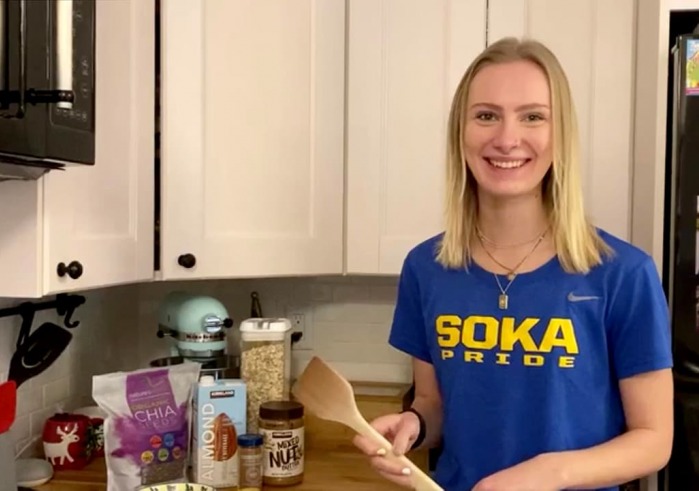Diet and Disease: Learning to Eat Healthier on a Budget

More than four million Californians were receiving benefits from CalFresh, the state’s food assistance program, at the start of 2020. When the pandemic hit, more people than ever found themselves struggling to pay for food and signing up for benefits. At the same time, the pandemic reminded people of the link between healthy eating and a strong immune system.
For individuals and policy experts alike, the question is how to spend less on food while eating a nutritious diet?
Kennah Watts ’22 wanted to help find a solution. She created a document to educate people about nutrition and offer healthy recipes using affordable ingredients. “I wanted healthy eating to be seen as more accessible,” Watts said, “and not just a luxury for people who can afford fancy cookbooks or fitness guides.”
Watts’ guide includes breakfast, lunch, snack, and dinner ideas based on the monthly allowance for CalFresh recipients. It also provides nutritional information for each meal, and explanations about why certain foods are healthier choices than others. Watts posted the guide on LinkedIn, so anyone with Internet access could view it. She wants to spread the information more widely and plans to send the guide to CalFresh as well as local health organizations.
Watts created the guide as a final project for Diet and Disease, a Soka Learning Cluster course. Learning Cluster, Soka’s intensive three-and-half-week winter block session, offers classes co-designed by students and faculty during the Fall semester. They allow a deeper examination of subjects of all kinds, and aim to contribute to positive change in the community.
Lisa Crummett, associate professor of biology, developed the January course to examine how diet relates to human health and chronic disease. She’s been fascinated by the topic for years.
Prof. Crummett teaches Human Body in a Modern World, which looks at the global industrial diet and how food is directly related to metabolic disease. She wrote a chapter about the connection between sugar and disease in a recently published book, The Shapes of Epidemics and Global Disease, edited by Cal State Fullerton’s Andrea Patterson and SUA’s Ian Read.
So it was natural for her to offer the topic as a Learning Cluster course. On the online bulletin board that replaced lunch-table discussions during this pandemic-altered year, she posted about her interest in studying diet and metabolic disease. A number of students commented that they would like to look into the connection between socioeconomic status and disease, how access to food and inability to buy healthy food influences why people eat the way they do, and why low-income groups are much more likely to acquire insulin resistance, type 2 diabetes, and cardiovascular disease.
The three-hour-long classes were conducted online, so professors had to get creative in order to fight Zoom fatigue. Some professors had students lead discussion forums instead of holding lectures, and others had students create avatars of themselves on gather.town to interact in a digital classroom.
The Diet and Disease class welcomed Guillermo Alvarez, a program coordinator from Latino Health Access, a grassroots organization in Santa Ana that combats public health problems in local communities of uninsured and underserved families. Whether it’s through helping someone control their diabetes or getting people vaccinated for Covid-19, the organization envisions a “healthy, equitable, inclusive and prosperous community that is engaged and civically active.”
Latino Health Access is a network of promotores—employees and volunteers who build trust and create lasting relationships within their neighborhoods. They educate their communities about breast cancer, diabetes, domestic violence, parenting, obesity, and many other public health issues. Alvarez invited students interested in non-profit work to volunteer with LHA.
Later in the course, students also had the opportunity to learn knife skills from chef Jessica Van Roo, assistant director of Culinary Recreation and Experiential Programs at UC Irvine. She joined students for a Zoom lesson on how to prepare and cook meals at home, demonstrating various cooking techniques, how to prepare meals in advance to save on prep time on weekdays, how to correctly hold a knife, and how to safely and easily chop different types of vegetables. Students participated with their own knives, cutting boards, and vegetables.
The session was similar to what Van Roo does in her nutrition classes at UCI and her work at the UCI recreation center. The training is often geared towards medical students. In the United States, medical students learn to treat disease but often miss out on learning how to prevent disease in the first place—which is where Van Roo hopes to make a difference. At the end of the class session, she invited Soka students to reach out to her for possible internship opportunities.
After learning these new cooking techniques, Prof. Crummett asked students to get into their own kitchens and film themselves cooking a meal. With students attending the class from all over the world, dishes ranged from gimbap to banana pancakes to cauliflower tacos and pico de gallo.
Will Schult ’22 shared how to make curried lentils in his cooking video, and for his final project, decided to make an informational website about the health effects of added sugar, with further emphasis on its prevalence in drinks. It also discussed options for how to remove added sugar from your diet.
“My favorite part of the class was how much it forced me to reassess my diet,” Schult said. “Over the course of it, I was able to make immediate and significant changes in how I ate and how my diet made me feel.”
To find out more about the other learning clusters offered this year, read the article From Disneyland to Data Analysis: 2021’s Learning Clusters.
—Nagisa Smalheiser ’21
